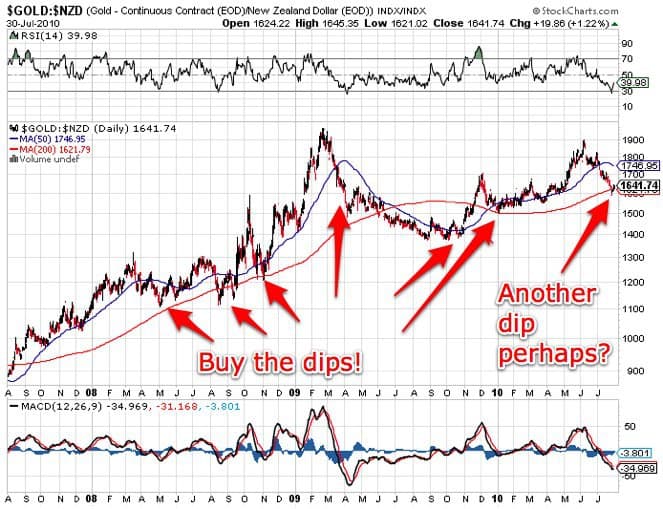An article on Stuff.co.nz this week was headlined “Bullion bullish but beware the bears”.
The excerpt below is taken from the beginning of the article (emphasis added is ours):
The price of gold, now near nominal highs at more than US$1180 an ounce, is expected to climb further, analysts say.
However, they warn New Zealand investors should be wary of exchange rate fluctuations.
Fund manager Liontamer, a specialist in capital protected funds, said the price could rise more than 15 per cent to over US$1400 an ounce by December 31, and continue rising well into 2011.
Investment manager Sean Butler said there was fundamental support for the gold price at current levels. “Central banks in China, India and Russia continue to buy gold, and investors are building up their gold exposures in the wake of global market uncertainty and the risk of higher inflation.“In the meantime, the supply of gold is tightening. A combination of reduced supply and the large set-up costs associated with setting up new mines is helping to set a new floor under the price of the precious metal,” Butler said.
OM Financial senior dealer Kevin Morgan said the price “could be comfortably above US$2000 an ounce within 18 months”, but saw a possible dip to US$1050 in the next two months.
“I would view that as a buying opportunity,” Morgan said, but cautioned anyone investing in gold to remember that it is priced in US dollars and subject to currency fluctuations.
“A New Zealand investor who purchased gold in early 2009 at US$900 an ounce would actually be losing money despite gold being 25 per cent higher at US$1200 an ounce today.
“The reason for this is that back in early 2009 the NZD [New Zealand dollar] was trading at about 0.5 to the USD [United States dollar] and today we are trading closer to 0.72,” he said.
No Counter Party Risk:
Talk about over complicating things! Firstly, Liontamer’s new fund – as also discussed in this Otago Daily Times article – uses derivatives to track the gold price. It doesn’t actually hold bullion. While it does offer capital protection – i.e. you will get back at least 100% of your money at the end of the 6 year investment period – this is also achieved using derivitivisation.
The reason we choose physical gold is because it has no counterparty risk. This simply means we are not relying upon another party to remain solvent to get our funds back one day. If we buy physical gold and take possession it is ours and ours alone. Our only risk is keeping it safe from prying eyes and thieving hands.
The Price of Gold in Any Currency is Volatile!
Secondly is the point that as per the Otago Daily Times article “the Liontamer index follows the movements in the international gold price and is not affected by currency [movements] between the New Zealand and US dollars.”
The stuff.co.nz article also mentions how Kiwi investors should be careful as gold “is priced in US dollars and subject to currency fluctuations”.
The thing is you don’t need to invest in a fund tracking the international/US dollar gold price using derivatives to handle currency fluctuations! All you have to do is track the NZ dollar gold price yourself (simply the USD gold price converted to NZ dollars by the current USD/NZD exchange rate) and ignore what the media says about the US dollar gold price! We live in New Zealand not the USA! (As a bonus, you’ll also avoid paying fund managers fees!).
Best Time to Buy Gold
If you believe gold remains in a bull market (or rather that paper currencies are still in a bear market), then the time to buy is when the NZD price of gold has fallen not when it is soaring. This can be an emotionally difficult thing to do but this gets you the most bang for your buck – or rather the most ounces for your dollars. You don’t actually need complex financial instruments and hedging with futures contracts to achieve this. Just buy when the price has fallen as this is likely to be when the NZ dollar is strong.
>> Learn More About Technical Analysis: Gold and Silver Technical Analysis: The Ultimate Beginners Guide
NZD Gold 3 Year Chart – Buy the price dips
Do this on a regular basis and the average buy price will be at a good low level and allow for maximum upside and you should hopefully avoid the heavy feeling of watching the price drop sharply just after you’ve bought.
In the above 3 year chart you can see that the NZ dollar price of gold has just dipped down to the 200 day moving average (the red line). Over the past 3 years this has generally been a good time to buy, with June last year being the only time the price fell substantially further below the moving average.
Our website has gold price graphs from 1 day all the way to 40 years – all in NZ Dollars. (See Gold Survival Guide Gold and Silver Price Charts.) The 1 year, 2 year and 5 year charts are particularly useful in seeing where the current price is compared to the past and can help identify when the price dips.
Anyway, that’s just our opinion and as always we offer it freely – but with no guarantees!
>> Learn More: Why You Should Ignore the USD Gold Price When Buying in New Zealand



Pingback: Update on silver bullion in NZ dollars | Gold Prices | Gold Investing Guide
Pingback: Buying Precious Metals: Common Questions from First Time Buyers | Gold Prices | Gold Investing Guide
Pingback: Why You Should Ignore the USD Gold Price When Buying in New Zealand - Gold Survival Guide
Pingback: What Does Gold Spot Price (Or Silver Spot Price) Mean? - Gold Survival Guide